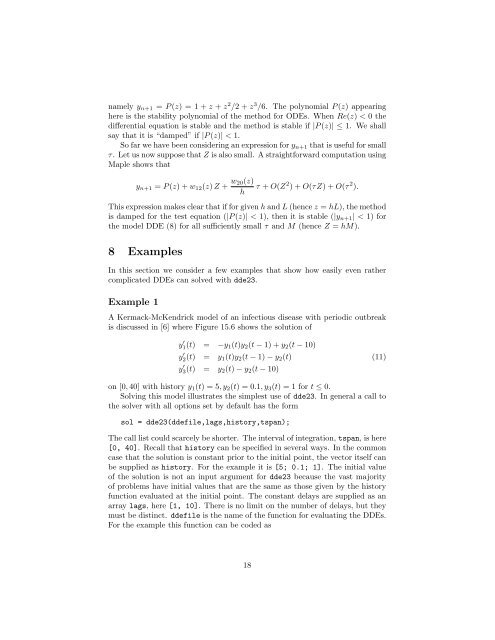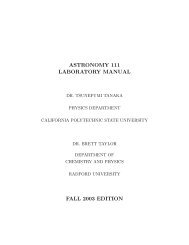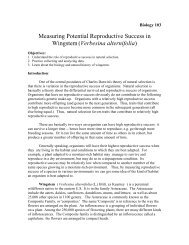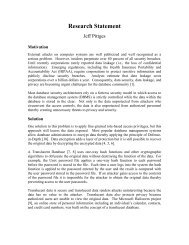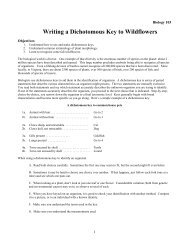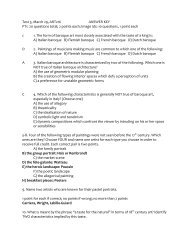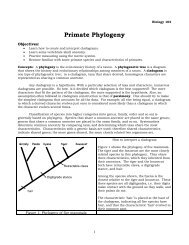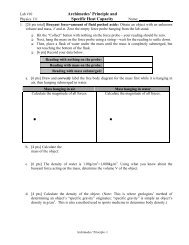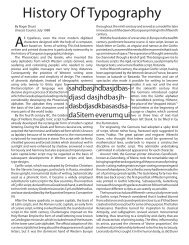Solving DDEs in Matlab - Radford University
Solving DDEs in Matlab - Radford University
Solving DDEs in Matlab - Radford University
Create successful ePaper yourself
Turn your PDF publications into a flip-book with our unique Google optimized e-Paper software.
namely yn+1 = P (z) = 1 + z + z 2 /2 + z 3 /6. The polynomial P (z) appear<strong>in</strong>g<br />
here is the stability polynomial of the method for ODEs. When Re(z) < 0 the<br />
differential equation is stable and the method is stable if |P (z)| ≤ 1. We shall<br />
say that it is “damped” if |P (z)| < 1.<br />
So far we have been consider<strong>in</strong>g an expression for yn+1 that is useful for small<br />
τ. Let us now suppose that Z is also small. A straightforward computation us<strong>in</strong>g<br />
Maple shows that<br />
yn+1 = P (z) + w12(z) Z + w20(z)<br />
h<br />
τ + O(Z 2 ) + O(τZ) + O(τ 2 ).<br />
This expression makes clear that if for given h and L (hence z = hL), the method<br />
is damped for the test equation (|P (z)| < 1), then it is stable (|yn+1| < 1) for<br />
the model DDE (8) for all sufficiently small τ and M (hence Z = hM).<br />
8 Examples<br />
In this section we consider a few examples that show how easily even rather<br />
complicated <strong>DDEs</strong> can solved with dde23.<br />
Example 1<br />
A Kermack-McKendrick model of an <strong>in</strong>fectious disease with periodic outbreak<br />
is discussed <strong>in</strong> [6] where Figure 15.6 shows the solution of<br />
y ′ 1(t) = −y1(t)y2(t − 1) + y2(t − 10)<br />
y ′ 2(t) = y1(t)y2(t − 1) − y2(t) (11)<br />
y ′ 3(t) = y2(t) − y2(t − 10)<br />
on [0, 40] with history y1(t) = 5, y2(t) = 0.1, y3(t) = 1 for t ≤ 0.<br />
<strong>Solv<strong>in</strong>g</strong> this model illustrates the simplest use of dde23. In general a call to<br />
the solver with all options set by default has the form<br />
sol = dde23(ddefile,lags,history,tspan);<br />
The call list could scarcely be shorter. The <strong>in</strong>terval of <strong>in</strong>tegration, tspan, is here<br />
[0, 40]. Recall that history can be specified <strong>in</strong> several ways. In the common<br />
case that the solution is constant prior to the <strong>in</strong>itial po<strong>in</strong>t, the vector itself can<br />
be supplied as history. For the example it is [5; 0.1; 1]. The <strong>in</strong>itial value<br />
of the solution is not an <strong>in</strong>put argument for dde23 because the vast majority<br />
of problems have <strong>in</strong>itial values that are the same as those given by the history<br />
function evaluated at the <strong>in</strong>itial po<strong>in</strong>t. The constant delays are supplied as an<br />
array lags, here [1, 10]. There is no limit on the number of delays, but they<br />
must be dist<strong>in</strong>ct. ddefile is the name of the function for evaluat<strong>in</strong>g the <strong>DDEs</strong>.<br />
For the example this function can be coded as<br />
18


